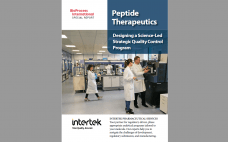Gastric delivery is unachievable for most biopharmaceuticals, so drug developers formulate biologics primarily for intravenous infusion or injection. However, inhaled and nasal delivery options are attracting considerable attention because they enable targeted delivery of a wide range of therapeutic proteins. On 23 June 2020, Mark Parry (technical director at Intertek) presented an “Ask the Expert” webinar that described critical considerations for inhaled and nasal delivery for biologics. Parry’s Presentation Because biopharmaceuticals are complex products, developers need compelling reasons to choose…
Sponsored Content
Ask the Expert: Ultrapure Gelatin Can Optimize Your Excipient Screening for Vaccine Formulation
In his 28 May 2020 “Ask the Expert” presentation, Jeroen Geeraerts (business development manager at Rousselot) highlighted that, as of May 2020, 118 candidate vaccines for the novel coronavirus (SARS-CoV-2) had reached clinical or preclinical evaluation. Of those, 11 use inactivated and live–attenuated approaches, which require strong stabilizing agents to maintain vaccine potency. Geeraerts explained why inactivated and live–attenuated vaccines require stabilizing agents and why vaccine companies prefer pharmaceutical-grade gelatin for such applications. Next, Geeraerts described how his company’s X-Pure…
Ask the Expert: An Innovative System for Advanced, High-Throughput Aggregate Analysis
Distinguishing aggregated active pharmaceutical ingredients (APIs) from other particle types is critical to evaluating a protein product’s stability, but standard characterization tools struggle to discriminate proteins from nonproteins with similar sizes, shapes, and morphologies. In a 25 June 2020 “Ask the Expert” webcast, Bernardo Cordovez (founder and chief scientific officer of Halo Labs) introduced his company’s Aura subvisible-particle analyzer. He explained how the device combines an innovative microscopy technique with sophisticated imaging software to characterize subvisible particles more quickly and…
CHOgro® High Yield Expression System: Achieve Higher Titers Faster in Suspension CHO Cells
This webcast features: Leisha Kopp, Applications Scientist, Mirus Bio Suspension Chinese Hamster Ovary (CHO) cells are often utilized for protein expression in biomanufacturing given their capacity for high-density growth in chemically defined media, human-biosimilar posttranslational modifications, and strong history of regulatory approval by the US Food and Drug Administration (FDA). However, many early stage researchers rely on HEK 293 systems for screening candidate compounds because of additional costs and time associated with production in CHO cells. The CHOgro® High Yield…
Enabling Large-Scale Production of Viral Vectors in the Gibco™ CTS LV-MAX Lentiviral Production System
This webcast features: Jonathan Zmuda, PhD, Director, Cell Biology, Life Science Solutions Group, Thermo Fisher Scientific The Gibco™ Cell Therapy Systems (CTS™) LV-MAX™ Lentiviral Production System enables scalable, high-titer production of lentiviral vectors using HEK293F-derived Gibco™ CTS™ Viral Production Cells adapted for high-density suspension growth in chemically defined, serum-free, and protein-free Gibco™ CTS™ LV-MAX™ Production Medium. Enhanced lentiviral production is enabled through the synergistic interplay of the LV-MAX components (including cells, production medium, supplement, enhancer, and transfection reagent), all of…
Breaking the Bottlenecks: Accelerating Viral Vector Bioanalysis in Downstream Processing
The rise in popularity of viral-vector–based gene therapies and SARS-CoV-2 vaccines has created a shortage of manufacturing capacity, driving efficiency improvements to avoid bottlenecks in bioanalysis to support culture optimization and bioprocessing steps. To improve workflows in bioanalytical assay development and sample analysis, more efficient methods are needed that include higher throughput, simpler and more streamlined sample assay methods, wide dynamic ranges, and efficient data processing and interpretation. Gyrolab™ microfluidic, nanoliter-scale immunoassay systems provide an innovative, robust solution to high-performance…
A Smart Path for Novel Biologics
Roche Pharma Research and Early Development (pRED) was faced with a challenge: double the number of projects in process development without significantly increasing headcount. Pawel Linke, a pRED lab automation specialist, tells the story of how the group approached this challenge with a focus on obtaining high quality data through automation and by integrating independent lab systems and devices to streamline their workflow. Implementation of high-throughput process development systems requires an orchestrated approach of both hardware and software solutions, so…
Embedding Your Drug Strategy Within a Solid Foundation for Success
Demand for drugs and therapeutics is growing thanks to the globalization of pharmaceutical-based medicine. Manufacturing new drugs and getting them to market faster, more economically and safely demands development strategies and business models that support successful outcomes for both investors and patients. Outsourcing has become an increasingly attractive business model for pharma as companies seek partners who can deliver comprehensive end-to-end drug substance and drug product development. It has prompted contract manufacturing organizations (CMOs) to consolidate and expand to create…
Peptide Therapies: Designing a Science-Led Strategic Quality Control Program
Peptide therapeutics are a unique class of pharmaceuticals. They can fall into one or more regulatory categories: as conventional chemical molecules, biological entities, or biosimilars. Developing a well–thought-out quality control (QC) strategy is key to meeting development milestones and complying with evolving regulatory requirements. Safety assessment is critical because slight changes in the structure, physicochemical properties, stability, and impurity profile of a peptide can provoke an adverse immune response. A robust analytical QC program should be conducted in laboratories that…
PendoTECH looks to compact photometer for post-filtration turbidity measurements
PendoTECH has upgraded its single use turbidity measurement system to improve performance, dynamic range, and overall usability Turbidity is the relative clarity of a liquid as the result of suspended solids in the liquid. Turbidity measurements typically use a beam of light to detect the presence of particles by measuring the difference between the amount of light that is emitted from a light source and the amount that is received by a detector. Measurements are affected by the size, shape,…








